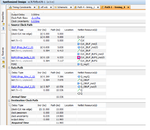preethi19
Full Member level 5
Hi i am learning Static Timing analysis in vivado. I am working on a simple D-flip flop with 2 inputs (CLK and D) and 2 outputs (Q and Qbar). So i have given delay to the input D of 3ns and i can see that the input is delayed by 3ns (meaning say if the data is to arrive at 5ns then it arrives at 8ns ie 5+3=8ns)...But for output delay i have given 3ns delay. The output slack calculation is done by "Required time - Arrival time". So say my data is required to be present at 15ns and the arrival time is 10ns. I thought then if the arriving time is 10ns then with delay of 3ns sec i would get the data to arrive at 13ns (which is still within the required time). But when i checked the analysis done in vivado i can see the output delay is getting subtracted from the required time ie (15-3=12)... I have written rough numbers here. I have attached an image which would be more clear.

Can someone pls explain this concept..

Can someone pls explain this concept..